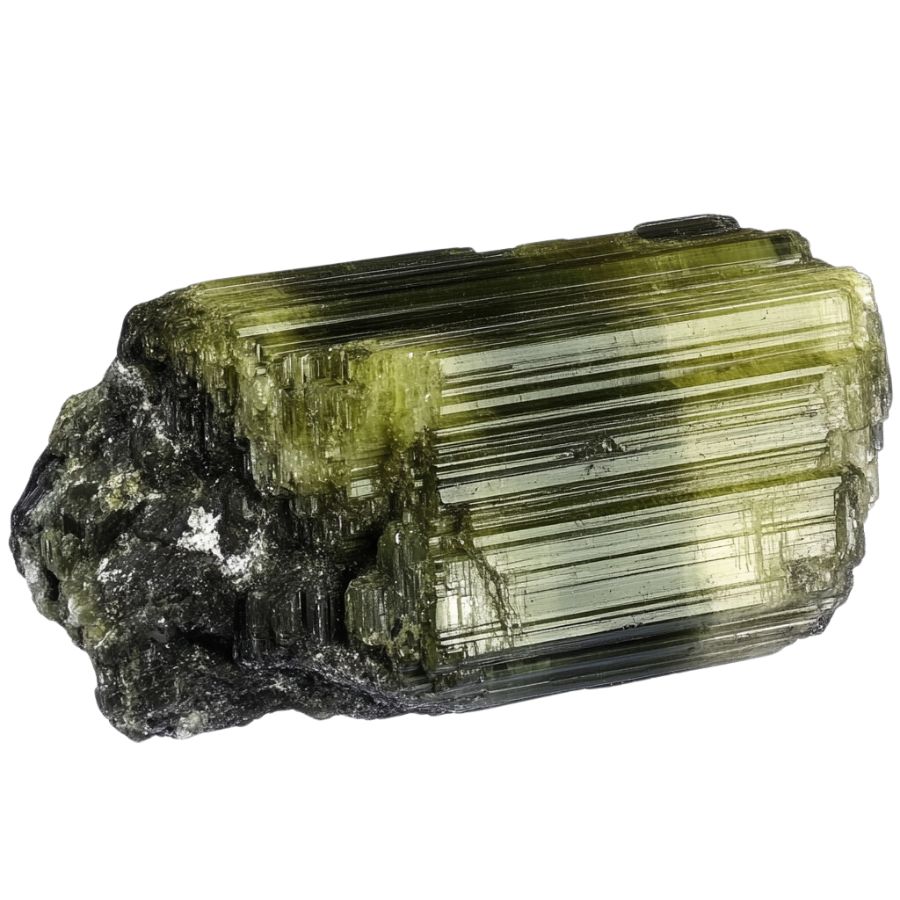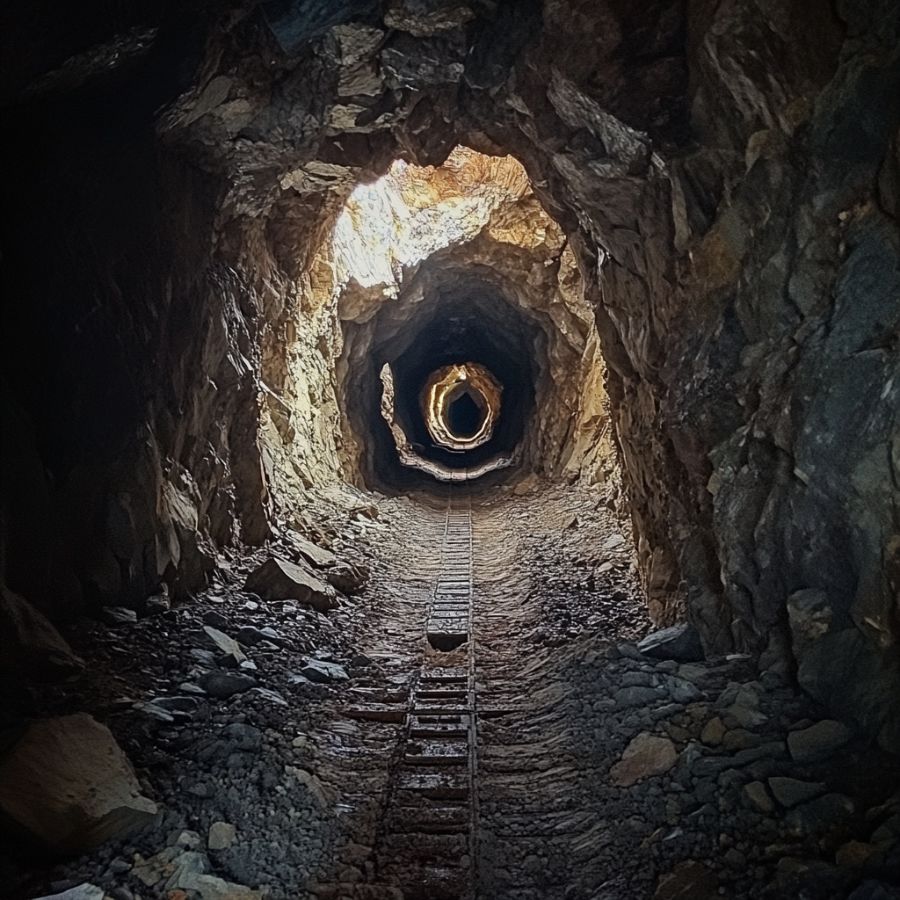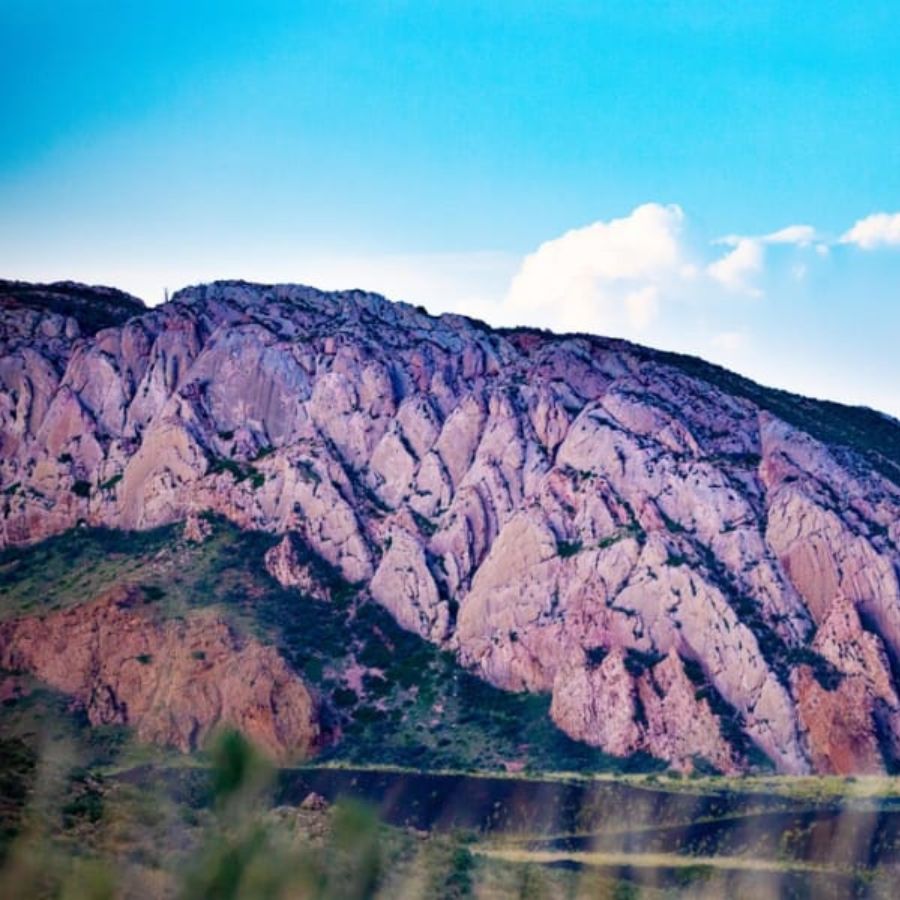With over 7,300 recorded caves, Missouri state sits on some seriously interesting geology.
While tourmaline isn’t as common here as it is in places like California or Maine, dedicated rockhounds still find nice specimens in several spots across the state. The trick is knowing exactly where to look.
We’ve spent months talking to local collectors and geologists to find the most promising locations for tourmaline hunting in Missouri.
No more wasted weekends at empty dig sites – these spots have been tried and tested by fellow rock enthusiasts.
How Tourmaline Forms Here

Tourmaline forms deep underground through intense heat and pressure. It originates from hot, mineral-rich fluids that move through fractures in rocks like granite and pegmatite. As these fluids cool, the minerals within them start to crystallize, forming tourmaline.
The color of tourmaline depends on the specific minerals involved, leading to a wide range of hues including pink, red, green, and blue.
Over millions of years, these crystals grow and become the beautiful, multifaceted stones we see today. Tourmaline is prized for its variety of colors and is often used in jewelry and decorative items.
The Types Of Tourmaline
Several incredible types of Tourmaline can be found in the US as well as in our state. Each is uniquely beautiful and interesting including:
Elbaite

Elbaite is found in pink, red, green, blue, yellow, and even colorless forms. What makes elbaite special is its ability to show multiple colors in a single crystal, like the famous “watermelon” tourmaline with pink and green hues.
This gem stands out due to its complex chemical makeup, which includes lithium, sodium, and aluminum. This composition gives Elbaite its diverse color range and dichroism, allowing it to display different colors when viewed from different angles.
Elbaite has a unique place in history as the first tourmaline variety in which lithium was discovered back in 1818. Some rare types, like the neon blue Paraiba elbaite, are highly sought after by collectors and jewelers.
Schorl

Schorl is known for its deep, rich color. It typically forms long, prismatic crystals with a shiny, glass-like surface when polished. Unlike other tourmalines, schorl gets its distinctive black color from high iron concentrations.
One of Schorl’s most fascinating features is its ability to become electrically charged through heating or rubbing. When charged, it can attract or repel small particles.
This unique electrical property makes Schorl valuable in various industries. It’s used in electronics and manufacturing to control static electricity and electromagnetic interference.
Despite being less colorful than other tourmalines, schorl’s practical applications make it an important and interesting variety.
Rubellite

Rubellite stands out with its vibrant pink to red colors. The most prized ones show a pure, saturated red without any brown or orange hints. This beautiful color comes from manganese in its makeup.
One cool thing about rubellite is its double refraction. It can look like it has two different colors when you view it from different angles.
Dravite

Dravite, or Brown Tourmaline, comes in shades from dark brown to light brown-yellow. It can look a bit like Smoky Quartz, with a semi-see-through quality.
Its crystals are often needle-like or prismatic, with points at both ends. This sets it apart from other tourmalines like the darker schorl or the colorful elbaite.
What makes dravite special is its rich sodium and magnesium content. This sets it apart from other tourmalines. It was first discovered in 1883 and named after the Drava River in Slovenia.
Indicolite

Indicolite is a rare and captivating blue to blue-green stone. It’s prized for its pure, bright blue color, which is considered the rarest within the tourmaline family. The hues can range from light blue-green to deep, rich blue, often with high clarity.
What sets Indicolite apart is its unique optical effects. It shows pleochroism, appearing to change color when viewed from different angles. Some specimens also display chatoyancy, creating a “cat’s eye” effect when cut in a certain way.
Indicolite is sometimes called “Brazilian sapphire” due to its resemblance to the precious gem. However, they’re different minerals.
The increasing demand for blue tourmalines has made indicolite highly sought-after in the gemstone market, appreciated for its beauty and rarity.
Watermelon Tourmaline

Watermelon tourmaline is truly one-of-a-kind. It looks just like a slice of watermelon, with a pink or red center and a green outer layer. This unique look happens because different elements join the crystal at different times as it grows.
These crystals often form in a rounded triangle shape. They’re see-through to somewhat clear and have a glass-like shine. When cut into slices, they really do look like little watermelons!
Cat’s Eye Tourmaline

Cat’s eye tourmaline is known for its mesmerizing chatoyancy effect. This creates a bright band across the stone’s surface, resembling a cat’s eye.
This stone comes in various colors, from green to pink to brown, and is usually semi-translucent to opaque.
What makes this stone special is the perfect alignment of tiny, needle-like inclusions inside it. These scatter light in a unique way, creating that eye-catching effect. It’s quite different from other tourmalines that don’t have this feature.
Unlike other cat’s eye stones, Tourmaline offers a wider range of colors and is often more affordable.
Achroite

Achroite is a rare, colorless variety of tourmaline that looks like a drop of clear water turned to stone. It’s completely transparent, making it unique among tourmalines which usually have color. The name comes from Greek, meaning “without color.”
What’s special about achroite is that it doesn’t change color when viewed from different angles. It means the stone can be cut in many ways without losing its clarity.
Verdelite

Verdelite is known for its beautiful green color. It can range from light green to deep emerald.
One thing that makes verdelite special is that you can find big, clear crystals of it. This isn’t always easy with other gemstones.
People love using verdelite in jewelry because its rich color and interesting light effects make it a popular choice for all kinds of accessories. Each piece of verdelite is like a little piece of nature you can wear.
Paraíba Tourmaline

Paraíba Tourmaline is a rare gemstone that catches the eye with its vibrant neon blue or green color. It’s like no other tourmaline you’ve seen before. The intense glow comes from copper in the stone, making it stand out from its cousins.
This stone is one of the rarest. For every 10,000 diamonds mined, only one Paraíba tourmaline is found.
It was only discovered in the late 1980s, making it a newcomer in the gem world. But Paraíba tourmaline’s unique color and rarity quickly made it a favorite among gem lovers.
Its discovery caused quite a stir in the gem community. Even small stones can be valuable because of how rare and beautiful they are.
What Rough Tourmaline Looks Like
When you’re out looking for rough Tourmaline on your own it’s important to know what you’re looking for. But before we dive into specifically what to look for you need to make sure you understand the type of rocks and minerals you’re seeing.
DON'T MISS OUT ON ANY GREAT FINDS!
While you're out searching for Tourmaline you're going to find A LOT of other interesting rocks and minerals along the way. The last thing you want to do is toss out something really interesting or valuable. It can be easy to misidentify things without a little guidance.
We've put together a fantastic field guide that makes identifying 140 of the most interesting and valuable rocks and minerals you will find REALLY EASY. It's simple to use, really durable, and will allow you to identify just about any rock and mineral you come across. Make sure you bring it along on your hunt!
Now, back to the identification specifics:
Here are some tips to help you recognize rough tourmaline.
Look for Color Variations

Tourmaline comes in many colors, like pink, green, blue, and even black. Some pieces have multiple colors, like watermelon tourmaline, which is pink and green.
If you see these color mixes, it’s likely tourmaline. Keep an eye out for vibrant shades.
Assess the Density and Weight

Rough tourmaline is relatively heavy for its size. If you pick up a piece and it feels denser than expected, it could be tourmaline. This weight can help you confirm your find.
Examine the Crystal Structure

Tourmaline features distinctive crystal shapes, ranging from slender and elongated to chunky forms. Look for triangular cross-sections and striations on the surface, which indicate its unique growth patterns.
Check for Transparency

Some rough tourmaline can be slightly transparent. If you hold it up to the light, you might see through it a bit. This transparency can be a good sign that you have tourmaline.
A Quick Request About Collecting
Always Confirm Access and Collection Rules!
Before heading out to any of the locations on our list you need to confirm access requirements and collection rules for both public and private locations directly with the location. We haven’t personally verified every location and the access requirements and collection rules often change without notice.
Many of the locations we mention will not allow collecting but are still great places for those who love to find beautiful rocks and minerals in the wild without keeping them. We also can’t guarantee you will find anything in these locations since they are constantly changing.
Always get updated information directly from the source ahead of time to ensure responsible rockhounding. If you want even more current options it’s always a good idea to contact local rock and mineral clubs and groups
Tips on where to look
Once you get to the places we have listed below there are some things you should keep in mind when you’re searching:
Look for Sedimentary Rocks

Sedimentary rocks are great places to find tourmaline. These rocks form from layers of sand, mud, and minerals. Over time, minerals like tourmaline can get trapped.
Look in riverbeds or areas where sediment has built up. You might find small pieces or even larger crystals.
Explore Mines

Mines are great spots to find tourmaline. Many mines across the U.S. extract various gemstones, including tourmaline.
Some mines even allow visitors to search for gems themselves. Always check if they have guided tours or special digging days.
Search in Gravel Pits

Gravel pits are often overlooked, but they can be treasure troves. These pits dig deep into the earth, exposing layers of rock.
Tourmaline can be found in the gravel. Just sift through the material carefully.
Some Great Places To Start
Here are some of the better places to start looking for Tourmaline in Missouri:
Always Confirm Access and Collection Rules!
Before heading out to any of the locations on our list you need to confirm access requirements and collection rules for both public and private locations directly with the location. We haven’t personally verified every location and the access requirements and collection rules often change without notice.
Many of the locations we mention will not allow collecting but are still great places for those who love to find beautiful rocks and minerals in the wild without keeping them. We also can’t guarantee you will find anything in these locations since they are constantly changing.
Always get updated information directly from the source ahead of time to ensure responsible rockhounding. If you want even more current options it’s always a good idea to contact local rock and mineral clubs and groups
Decaturville crater

The Decaturville crater is a massive impact site in central Missouri, about 16 miles north of Lebanon. This 3.7-mile-wide crater formed when a meteor hit Earth during the Permian period, less than 300 million years ago.
Today, you can see parts of the crater along Highway 5. The crater is special because it’s part of the 38th parallel structures – a line of round impact sites across the United States.
Scientists think these craters might have formed when several meteors hit Earth in a row long ago. The crash was so powerful it created unique rock formations called shatter cones and mixed-up rock layers called breccia.
Tourmaline crystals can be found in the crater’s exposed rocks. The best spot to look is along the Highway 5 roadcut. The central part of the crater, where the meteor hit hardest, is another good area to search.
Pilot Knob Mine

Pilot Knob Mine sits in Iron County, Missouri, as part of the St. Francois Mountains. This historic mining site rises 1,470 feet above sea level and towers 581 feet above the Arcadia Valley floor. The mine is located between the towns of Ironton and Pilot Knob.
The area’s rich mining history dates back to the 19th century when it was a major source of iron ore. The mountain formed from ancient volcanic activity, creating unique deposits of magnetite and hematite.
Tourmaline specimens have been found in the open mine workings along with other minerals like calcite, apatite, and barite. The best spots to look for these crystals are in the exposed rock faces and mineral veins throughout the old mining area.
Pea Ridge Mine

The Pea Ridge Mine is located 8.6 miles southeast of Sullivan in Washington County, Missouri. This underground iron mine is part of the Springfield-Salem Plateaus and has been an important mining site for many years.
The mine’s rocks are very old – over a billion years old! These rocks formed during the Precambrian period and are mostly made of minerals like magnetite and hematite.
Tourmaline can be found in the mine’s underground areas, along with many other interesting minerals. The mine is especially known for its rare earth elements, which are important for making modern electronics.
While looking for tourmaline, you might also find other minerals like calcite, quartz, and fluorite in the mine’s waste rock piles.
Iron Mountain

Iron Mountain is located in St. Francois County, Missouri, about six miles south of Bismarck. This historic mining area is famous for its rich iron ore deposits and unique mineral formations.
The best spots to look for tourmaline are near the old mine workings. The mountain’s quartz veins and pegmatites often contain this colorful crystal.
You’ll find most success searching through the rock piles and exposed outcrops around the former mining areas. The mix of volcanic rocks and later mineral formations created good conditions for tourmaline growth.
The area’s mining history goes back to the 1800s, and today it remains a fascinating spot for rock collectors.
Graniteville Area

Graniteville is a small community in Iron County, Missouri, known for its rich mining history and unique granite formations. The area sits close to Elephant Rocks State Park and features several active and historic quarries that have operated for over 150 years.
Tourmaline specimens have been discovered in the Sheahan Quarry’s pegmatite veins. These veins are like nature’s mineral treasure chests, packed with various crystals.
The best spots to look for tourmaline are near the exposed granite walls where pegmatite veins cut through the rock.
The quarry areas also produce other minerals like feldspar and mica. The mix of old mining sites and natural rock formations makes Graniteville an interesting spot for both history buffs and rock collectors.
Places Tourmaline has been found by county
After discussing our top picks, we wanted to discuss the other places on our list. Below is a list of the additional locations where we have succeeded, along with a breakdown of each place by county.
| County | Location |
| Marion | Fabius River |
| Iron | Shepherd Mountain |
| Washington | Potosi |
| Madison | Fredericktown |
| Cedar | Stockton |
| Benton | Lincoln |
| Boone | Grindstone Creek |
| Benton | Warsaw |
| McDonald | Indian Creek |
| Iron | Elephant Rocks State Park |
| St. Louis | Rockwoods Reservation |
| Washington | Hughes Mountain Natural Area |
| Taney | Branson |
| Camden | Lake of the Ozarks |
| Shannon | Current River |
| Ripley | Doniphan |
| McDonald | Elk River |
| Daviess | Grand River |
| Lewis | La Grange |
| Clark | St. Francisville |
| Lincoln | Troy |
| St. Louis | St. Louis area old mines |
| Cole | Cole County |
| Greene | Springfield |
| Jasper | Joplin |
| St. Francois | Flat River |
| Washington | Old Mines |
| Dade | Greenfield |
| Bollinger | Marble Hill |
| Christian | Ozark |
| St. Genevieve | St. Genevieve area mines |
| Dent | Salem |
| Marion | Hannibal |
| Reynolds | Lesterville |
| Madison | Millstream Gardens |
| Oregon | Grand Gulf State Park |
| Jefferson | Big River |


